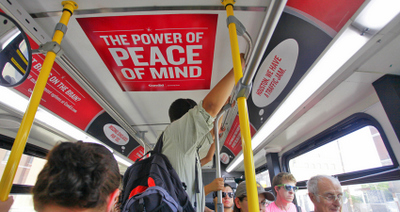
Radio sales is the act of getting brands and businesses on the air to promote products. These are an inexpensive and efficient way to reach a captive audience by delivering a relevant message.
A solid radio marketing campaign will make your business and products more successful, no matter if you're a novice marketer or an experienced one. Like any other type advertising, it takes knowledge to get the most out of a radio buy.
1. Understand Your Audience
Understanding your target audience is crucial to any radio purchase. This will save you money on channels and shows that are not reaching your ideal customer.

A great radio station sales rep can help you understand your listeners and give you information about their demographics. A good radio station sales rep can provide information about when and where your listeners most likely to hear your ads.
2. Radio Media Buyers
Most radio stations employ a sales team made up of media buyer or media specialists. They are responsible in finding and selling advertising space. These buyers work closely with regional and local advertisers to create creative radio packages that can be used long-term to promote their product, brand, or service.
They will offer suggestions on the best radio channels to reach your target market. They can recommend the most popular stations in your area and show you signal coverage maps to help you determine where your listeners live and work.
3. Know Your Ad Pricing
The cost of advertising on a radio station can vary depending upon the station and time of the day. Your radio sales rep will be able help you negotiate a price with your station that meets your goals and budget.

One of the biggest mistakes that many people make when advertising on radio is putting their ads on the wrong station or time. Numerous stations will show their commercials at different times and days depending on how it performs. But this is not always the best way for your ad to be seen by the audience that you desire.
If you're a restaurant owner, it is a good idea to look for a place that serves lunch and has high ratings. This will allow you to attract more customers in the segment and increase your business' overall success.
5. Partner with other businesses
It is worth trying to find similar companies if your niche product is popular. Contact other business owners and discuss the possibility of advertising together.
FAQ
What is affiliate market?
Affiliate marketing allows you to make money by referring people to other websites that sell products or services. If someone buys from your product, you get paid by the owner.
Referrals are the foundation of affiliate marketing. To get people to buy from your affiliate marketing, you don't have any special requirements. Simply refer people to the website.
It's possible to make money with no selling. Selling is as easy as buying.
It takes just minutes to set up an account as an affiliate.
The more people you refer, the more commission you will receive.
There are two types.
-
Affiliates who own their own websites
-
Affiliates who work in companies that offer products or services.
What is an advert buyer?
Advertising space is purchased by an advertiser on TV, radio and printed media.
Advertisers pay for the time their message appears.
They don't necessarily look for the best advertisement, but instead seek out the most effective way to reach their target market.
Advertisers may have demographic information such as the age, gender, marital status, income level, occupation, hobbies, and interests of their customers.
This information can be used by advertisers to decide which media works best for them. An example is direct mail that appeals to older people.
Advertisers also take into account the competition. Advertisers may choose to place ads near competitors if there are similar businesses in the area.
Advertisers also need to consider their budget size and how long they will spend it before it expires.
What are the basics of radio advertising?
Understanding the interactions between different media is essential. The most important thing to remember is that all forms of media are complementary rather than competitive.
Radio is best used as an extension of television advertising. It complements TV by reinforcing key messages and providing additional information.
Radio listeners are often not able to handle long TV commercials. Radio ads are often shorter and cheaper.
How much does it take to advertise on social networks?
If you decide to go this route, you should know that social media advertising is not free. Based on the time spent on each platform, you will be charged monthly.
Facebook - $0.10 Per 1,000 Impressions
Twitter - $0.20 Per 1,000 Impressions (if you tweet).
Send out invitations on Linkedin for $0.30 per 1000 impressions
Instagram: $0.50 per 1,000 impressions
Snapchat - $0.60 for 1,000 impressions ($0.40 Per User)
YouTube – $0.25 per 1000 views
Tumblr: $0.15 per 1,000 impressions of text posts
Pinterest - $0.05 per 1,000 impressions per month
Google + - $0.15 - $0.20 per 1 Million Impressions
Tumblr – $0.15 - $0.20 per 100,000 impressions
Vimeo - $0.20 - $0.25 for 10,000 impressions
Soundcloud – $0.20-$0.25 for 1 million plays
StumbleUpon - $0.20 -$0.25 per 1 billion pageviews
Digg - $0.20- $0.25 for 1000 diggs
Reddit - $0.20 - $0.0.25 per 1000 Comments
Wordpress - $0.20--$0.25 per 500 comments
Flickr - $0.20 -- $0.25 per 5,000 photo uploads
How do I choose my target market?
Start with yourself and those close to you. If you don't know where to begin, ask yourself, "who am I trying to reach?"
Ask yourself these questions: Who do you consider the most influential in your industry? What problems do they deal with daily? Who are the smartest people in my industry? They hang out online.
Start at the beginning of your business. What was your motivation for starting? What problem did you solve for yourself, and how did you do it?
These questions will enable you to identify your ideal client. You'll also learn more about what makes them tick and why they buy from you.
For clues on who your competitors cater to, check out their websites and social media pages.
Once you have identified your target customer, you need to decide the best channel to reach them. If your company offers services to real estate agents you might make a website that targets home buyers.
A blog that targets small-business owners could be a possibility if you are a software provider.
If you sell clothing, you could create a Facebook page for teens. You could also set up a Twitter account if your restaurant is a business owner to help parents find kid-friendly restaurants.
You have many options to convey your message.
Advertising: What is it?
Advertising is an art form. It's more than just selling products. It's all about creating emotional connections between people with brands.
Advertising is about sharing stories and using images for ideas.
Communicating clearly and persuasively is key. Your target market should be able to relate to the story you tell.
Advertising is thus different from other forms, such public speaking, writing, and presentations.
You are building a brand identity when you run a successful advertising campaign.
This is how you make yourself memorable. You become someone who people want to remember.
What are the basics of television advertising?
Television advertising has the potential to reach large audiences at once. It was also expensive. However, it can be powerful if you use the device correctly.
While there are many types and styles of TV ads, most share some common traits. You must ensure your TV ad fits within the category it is being placed. It is not a good idea to try and run a lifestyle TV commercial while running a product or service commercial. Your message should be consistent throughout the entire campaign.
A second important thing to keep in mind is that prime-time hours is the best time to air ads. This is because most viewers watch TV while relaxing in front of the set. You want them relaxed enough that they can focus on you words.
Last but not least, just because you have a lot of money does not mean that you will get great results. The opposite may actually be true. According to University of California research, commercials airing during popular shows are less likely to be seen and sell more products than those which air during unpopular shows. Make sure you are doing it right if you're spending a lot on TV advertising.
Statistics
- Nonetheless, advertising spending as a share of GDP was slightly lower – about 2.4 percent. (en.wikipedia.org)
- Advertising's projected distribution for 2017 was 40.4% on TV, 33.3% on digital, 9% on newspapers, 6.9% on magazines, 5.8% outdoor, and 4.3% on radio. (en.wikipedia.org)
- Worldwide spending on advertising in 2015 amounted to an estimated US$529.43 billion. (en.wikipedia.org)
- It's 100% reliant on your website traffic. (quicksprout.com)
External Links
How To
How does one place an advertisement on a billboard?
Billboards were popularized by the United States Army during World War II. They became a standard fixture along roadsides and highways. Most billboards contain text advertising. However, some have photographs or art. While most billboards are static, others display messages that change regularly, such as weather forecasts, sports scores, stock prices, and political events.
The majority of billboards are outside displays. However, there are indoor versions. Outdoor billboards are usually seen by motorists passing by them several times per day. Indoor billboards may only be viewed once every few year. Because it has three layers, the most common outdoor billboard type is the "cubic", which is made of two sheets glass sandwiched by a layer fiberglass mesh, This design allows air circulation through the billboard. It keeps it cool during hot weather and warm during cold.
Advertisers pay companies like Billboard Advertising Inc., which owns and operates many of North America's largest billboard advertising firms, to put their ads up on their billboards. Advertisers are then offered space on these billboards by these companies. These billboards are purchased by advertisers according to how much they wish to spend on advertising. These advertisers often choose the best location for their ads depending on how many people they are likely to see.
In addition to selling ad space, Billboard Advertising Inc. has contracts with local governments to erect signs on city property. Some cities allow billboards to be placed anywhere, while others limit them to specific areas. Chicago, for instance, has a restriction that billboards cannot be more than 1,000 feet from any highway. Others cities have a requirement that billboards are no closer to a school or church than 500 feet.
Billboard Advertising Inc. has agreements to promote products and/or services throughout the United States.